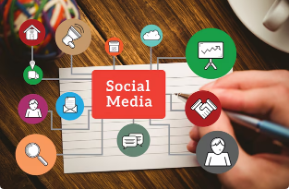In the digital age, social media has become a powerful tool for businesses to connect with customers, build brand awareness, and drive growth. With billions of active users on platforms such as Facebook, Instagram, Twitter, LinkedIn, and TikTok, businesses have unprecedented opportunities to reach and engage their target audiences. This article explores strategies for leveraging social media to achieve business growth, including building a strong online presence, creating engaging content, utilizing advertising options, and measuring success.
Building a Strong Online Presence
- Choose the Right Platforms
- Identify Your Audience: Understand where your target audience spends their time online. Different demographics favor different platforms. For example, LinkedIn is ideal for B2B marketing, while Instagram and TikTok are popular among younger consumers.
- Focus Your Efforts: Rather than spreading yourself thin across many platforms, focus on a few key platforms that align with your business goals and audience preferences.
- Optimize Your Profiles
- Consistent Branding: Ensure your brand’s visual identity, including logos, colors, and fonts, is consistent across all social media profiles.
- Complete Information: Fill out all sections of your profile with accurate and detailed information. Include your business’s website, contact information, and a compelling bio that clearly communicates your value proposition.
- Engage with Your Audience
- Responsive Communication: Respond promptly to comments, messages, and reviews. Engaging with your audience builds trust and fosters a sense of community.
- Encourage Interaction: Use polls, questions, and interactive posts to encourage followers to engage with your content.
Creating Engaging Content
- Content Strategy
- Define Objectives: Clearly define what you want to achieve with your social media efforts, whether it’s brand awareness, lead generation, customer support, or sales.
- Content Calendar: Plan and schedule your content in advance to ensure a consistent posting frequency. Use a content calendar to organize your posts and align them with key dates and campaigns.
- Content Types
- Visual Content: High-quality images, graphics, and videos tend to perform well on social media. Use visual content to capture attention and convey your message effectively.
- Stories and Reels: Utilize features like Instagram Stories, Facebook Stories, and TikTok Reels to share short, engaging videos that highlight your products, services, and company culture.
- User-Generated Content: Encourage customers to share their experiences with your products or services. Reposting user-generated content not only provides social proof but also engages your audience.
- Value-Driven Content
- Educational Content: Share tips, tutorials, and industry insights that provide value to your audience. Educational content positions your brand as a knowledgeable and trusted resource.
- Entertaining Content: Use humor, trends, and relatable content to entertain your audience. Entertaining posts can increase engagement and shareability.
- Promotional Content: While it’s important to provide value, don’t shy away from promoting your products or services. Use a balanced mix of content types to keep your audience interested.
Utilizing Advertising Options
- Targeted Ads
- Audience Segmentation: Use the detailed targeting options available on social media platforms to reach specific demographics, interests, and behaviors. Effective audience segmentation ensures your ads are seen by those most likely to convert.
- Lookalike Audiences: Create lookalike audiences based on your existing customer data to reach new potential customers who share similar characteristics.
- Ad Formats
- Image and Video Ads: Use high-quality visuals and compelling copy to capture attention and drive action. Video ads, in particular, can be highly engaging.
- Carousel Ads: Showcase multiple products or features within a single ad using carousel ads. This format is ideal for e-commerce businesses.
- Sponsored Posts: Promote your top-performing organic posts to reach a wider audience. Sponsored posts blend seamlessly into users’ feeds, making them less intrusive.
- Budget Management
- Set Clear Budgets: Define your advertising budget and allocate it strategically across campaigns and platforms. Start with a modest budget and adjust based on performance.
- Monitor and Optimize: Continuously monitor the performance of your ads. Use A/B testing to experiment with different creatives, copy, and targeting options. Optimize your campaigns based on data insights to maximize ROI.
Measuring Success
- Key Performance Indicators (KPIs)
- Engagement Metrics: Track likes, comments, shares, and overall engagement rates to gauge how well your content resonates with your audience.
- Reach and Impressions: Measure how many people have seen your content and how many times it has been displayed.
- Conversion Metrics: Track metrics such as click-through rates (CTR), lead generation, and sales to understand the impact of your social media efforts on your bottom line.
- Analytics Tools
- Platform Analytics: Use the built-in analytics tools provided by social media platforms to track performance metrics. Facebook Insights, Instagram Insights, and Twitter Analytics are valuable resources.
- Third-Party Tools: Consider using third-party analytics tools like Hootsuite, Sprout Social, or Buffer to gain deeper insights and manage your social media efforts across multiple platforms.
- Regular Reporting
- Monthly Reports: Create detailed monthly reports to analyze performance, identify trends, and adjust your strategy. Share these reports with your team to keep everyone aligned.
- Feedback Loop: Use insights from your analytics to refine your content strategy, ad targeting, and overall approach. Continuous improvement is key to long-term success.
Conclusion
Leveraging social media for business growth involves building a strong online presence, creating engaging content, utilizing targeted advertising, and measuring success effectively. By strategically approaching each of these areas, businesses can harness the power of social media to connect with their audience, enhance brand visibility, and drive growth. In the ever-evolving digital landscape, staying adaptable and responsive to new trends and technologies will ensure sustained success in social media marketing.









